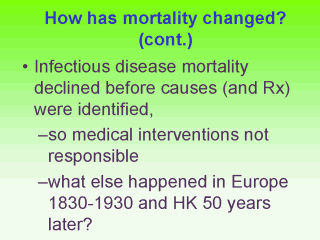| front |1 |2 |3 |4 |5 |6 |7 |8 |9 |10 |11 |12 |13 |14 |15 |16 |17 |18 |19 |20 |21 |22 |23 |24 |25 |review |
 |
However, to reiterate
and anticipate the second question, what were the reasons for the decline in childhood
mortality from infectious diseases? As the decline began before most causes were
identified, medical interventions cannot account for the changes. What else was happening in Europe between 1830-1930 and in HK from after WWII? The most notable development was the industrial revolution. This, together with sweeping changes in the laws governing land use, was preceded by and amplified a mass movement of people from the previously dominant agricultural sector to urban environements, often in search of work and higher wages in the emerging factories. This urban drift lead to considerable strain on the capacity of cities to cope with the food, sanitation and other resources. Poor housing, over-crowding and poor nutrition lead to an increase in infectious disease amongst the most vulnerable, the young, the very old, the poorly nourished and otherwise weakened. From around 1850 onwards growing attempts to introduce significant infrastructural and legislative means to help cope with the high levels of disease, crowned by the introduction of the Public Health Act in 1897 ensured standards for housing, sanitation, drinking water, food quality that were previously lacking. The gradual appearance of contraception and the increased childhood survival lead to smaller families, placing less reproductive strain on women, enabling better nourishment for children, compulsory education and improved wealth from industrial and colonial activities all contributed. |